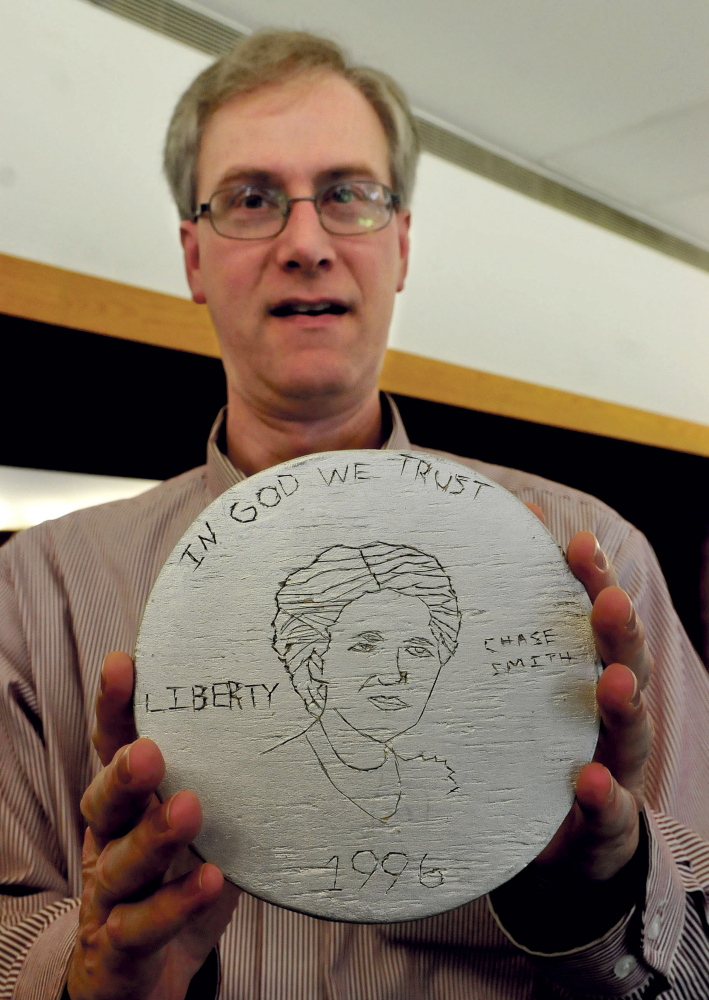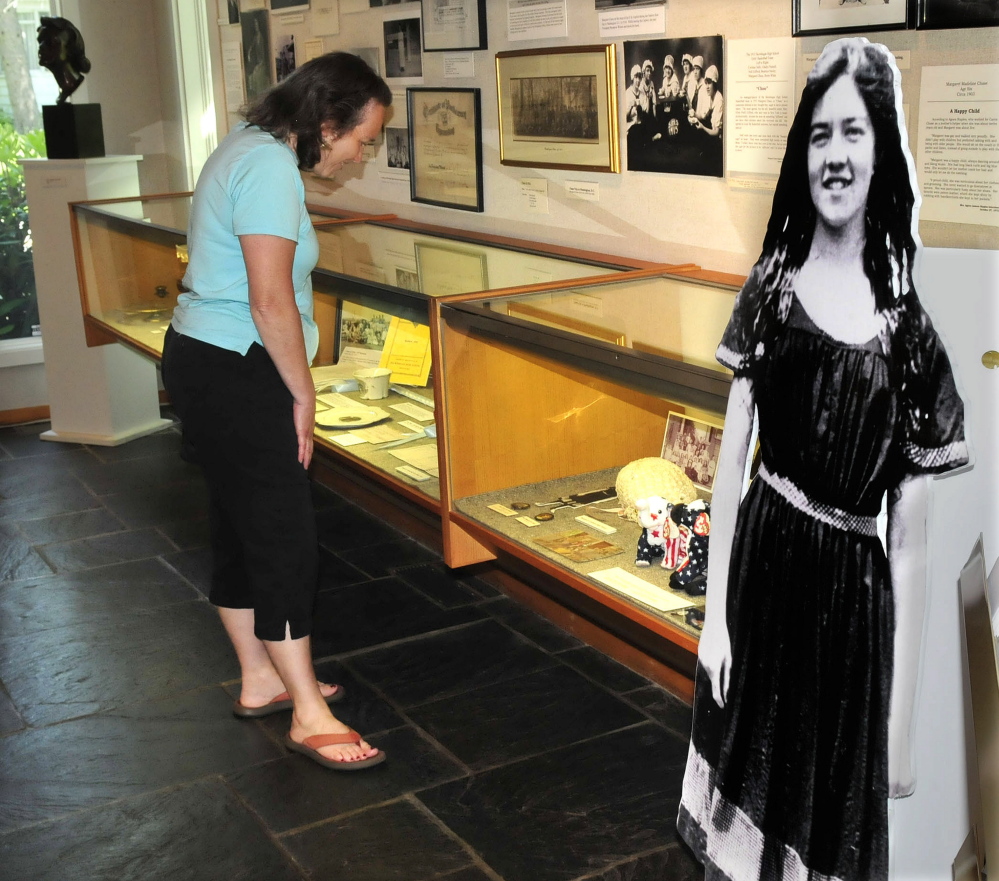SKOWHEGAN — When Sen. Margaret Chase Smith’s name was suggested for the new $1 coin in 1998, a fourth-grade girl at Benton Elementary School was so taken with the idea that she made a larger-than-life wooden coin painted silver with the late senator from Maine’s likeness etched into it.
The coin, made by Tia Nichols of Fairfield, has been kept at the Margaret Chase Smith Library in Skowhegan — Smith’s hometown — ever since. Now, with discussion of possibly replacing the likeness of Alexander Hamilton on the U.S. $10 note with that of an American woman, Smith’s name has come back around as a possible candidate.
David Richards, director of the Margaret Chase Smith Library in Skowhegan, said efforts to draw attention to Smith for the $10 bill have taken root on Facebook and elsewhere.
“First it was the National Women’s History Museum, which had done some mock ups of $10 bills,” Richards said.
The museum created mock-up notes with the image of suffragette Susan B. Anthony, African-American abolitionist Harriet Tubman and Eleanor Roosevelt, the longest-serving First Lady of the United States, Richards said.
“And then people started chiming in: ‘What about Margaret Chase Smith?’ So we started doing some posts on our Facebook page and it took off from there,” he said.
Richards said the board of directors of the Margaret Chase Smith Foundation began discussing the idea. Foundation vice president Merton Henry noted that in 1998, when treasury officials were looking to replace the Susan B. Anthony coin with the likeness of another woman, then-U.S. Sen. Olympia Snowe of Maine proposed Margaret Chase Smith.
Henry traveled to Philadelphia at the time to advocate for Smith, Richards said.
But Smith lost out to Sacajawea, the Indian woman who led Lewis and Clark on their famous expedition to find the Pacific Ocean.
Henry, who still sits on the foundation board, this past week said Smith’s role in American political life makes her an ideal candidate for the $10 bill.
“Because of Sen. Smith’s unique life, which spanned most of the 20th century, and her very major role in paving the way for women to participate in national politics, I think she is uniquely qualified to appear on the $10 bill,” Henry said. “With the passage of time, people forget about the struggle for women’s suffrage which culminated in the 19th Amendment in 1920 — less than a century ago.
“People also forget that Sen. Smith was an icon not only in Maine but nationally. A few years ago there was a TV program with all of the women U.S. senators in which each commented on Sen. Smith’s role as an inspiration to them.”
U.S. Treasury Secretary Jack Lew announced in January that the Treasury Department is redesigning the $10 bill to feature a woman. The current $10 bill features a picture of Alexander Hamilton, the nation’s first treasury secretary. While the new note will feature a woman, Lew said Hamilton won’t be completely replaced. That could mean the new design will feature a picture of Hamilton and a woman, or Hamilton will be featured on just some of the new $10 notes.
The final design will be announced later this year, although the new $10 note won’t go into circulation until 2020 — the 100th anniversary of the passage of the 19th Amendment, which gave women the right to vote.
The Treasury Department is inviting people to share ideas, symbols and designs that reflect what democracy means to them. Ideas can be shared on Twitter with the hashtag #TheNew10 or on the website thenew10.treasury.gov.
There also is a petition drive to get Margaret Chase Smith’s likeness on the new bill.
Names of prominent American women to grace the $10 bill have included Betsy Ross, who sewed the first American flag; former Associate Justice of the United States Supreme Court Sandra Day O’Connor; African-American Civil Rights activist Rosa Parks; and American Red Cross founder Clara Barton.
“To me one of the interesting things about Sen. Smith is what she accomplished given where she came from,” Richards said. “I’m always struck by the fact that when she graduated from Skowhegan High School in 1916 and they take their class field trip down to Washington, D.C., and they meet President Woodrow Wilson, that women still don’t have the right to vote in this country.”
Smith served for more than 30 years in the U.S. House of Representatives and in the Senate and was the first woman to make a competitive run for the presidency in 1964.
Penn State professor Nichola Gutgold and Jane Ramsey, the author and the illustrator of “Madam President,” a new children’s book that teaches girls they can be president, are scheduled to speak at 10 a.m. Tuesday at Margaret Chase Smith Library as part of the Skowhegan Free Public Library summer reading program.
Richards said Smith also stood up to Joe McCarthy — a U.S. senator from Wisconsin who spent almost five years trying in vain to expose communists and other left-wing “loyalty risks” in the U.S. government — with her “Declaration of Conscience” speech in 1950. That alone should qualify her as being one of America’s most dynamic women, Richards said.
Charles Cragin, president of the board of directors of the Margaret Chase Smith Foundation at the University of Maine, said Smith would be an ideal person to place on the country’s currency.
“She set an example of public service that needs to be emulated by every citizen in America,” Cragin said. “She truly focused on the importance of the connection between a government and its citizens.”
Cragin said Smith exemplified the qualities of honesty, frankness, dignity and firm determination.
“In addition to being the first woman elected in her own right to both branches of the Congress and the first woman nominated by a major political party for president, she was instrumental in the integration of women into our armed forces,” he said. “The result this year is that we have three- and four-star women generals and admirals leading America’s military. Her legacy runs deep and wide.”
In her statement in June 1998 in support of Smith’s likeness gracing the $1 coin, Snowe said Smith was “a woman of countless firsts.”
“Sen. Smith’s importance to the nation was not a fad,” Snowe said. “Rather, her legacy extended across nearly half a century as she blazed a trail for women in countless fields and professions while opening doors that had been long closed.”
Doug Harlow — 612-2367
Twitter: @Doug_Harlow
Send questions/comments to the editors.






Comments are no longer available on this story